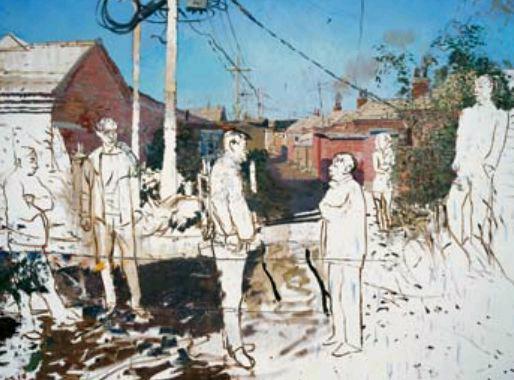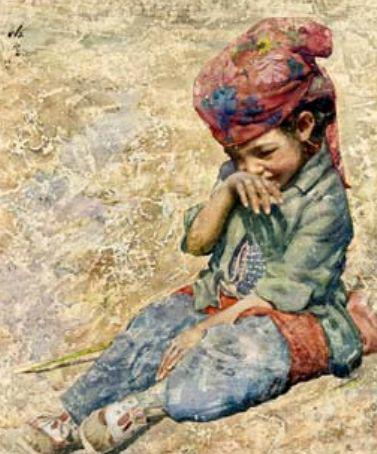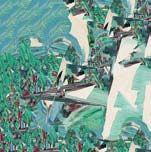Realist Liu Xiaodong
Realist Liu Xiaodong
Born in 1963 in Jinzhou City of Liaoning Province, Liu Xiaodong graduated from the oil painting department of the Central Academy of Fine Arts. As a realist, Liu Xiaodong endeavors to produce rational work. When modern art began dominating the art world in the late 1980s, Liu kept distance from the trend, opting to hold steadfastly to realism with focus on daily life and ordinary peoples situations. Over the years, Liu has become a representative of“new generation” artists and a favorite of collectors. Sensitive to the changes of the times, the artist depicts close relations between individual encounters and social absurdity, aiming at the profound meaning of life for every ordinary person.
Anwesen · The 2nd Chinese Oil Painting Biennial Exhibition (2014)
August 16 — August 26, 2014
National Art Museum of China, Beijing
Wasteful Art
Born in 1979 in Harbin in northeastern Chinas Heilongjiang Province, Wang Yuyang received a bachelors degree from the Central Academy of Drama and masters degree from the Central Academy of Fine Arts (CAFA). He now lives in Beijing and works at the experimental art department of CAFA. Although Wang employs new media in his work, he avoids intentionally highlighting the novelty of the techniques, opting instead to pay more attention to obsolete techniques, “broken” aesthetics and the artistic value of waste. He employs various media to express his ideas including installation, photography and painting. His work humorously explores the relationship between the human body, experience and cognition as well as the relationship between artificial reality, media, historical perception and body identity. Despite great diversity, his works all emit a clear “self.”
The 12th National Art Exhibition — The Section of Experimental Art
August 18 — September 8, 2014
Today Art Museum, Beijing
Vitality of Color
A native of Shanghai, Ha Ding (1923-2004), from the Hui ethnic group, excelled at watercolor and oil painting. In the 1940s, he gained fame for his portrait work in Shanghai. In the 1950s, he set up Ha Ding Studio, becoming one of the few artists to establish a private educational institution after 1949. The effects of heavy colors and strength create the flavor of Has work. The recent exhibition in China Art Museum of Shanghai includes Has watercolor and oil painting work from the 1940s all the way up to the 21st Century as well as some work from his students, comprehensively displaying the artists painting and teaching achievements.

Blanks and Colors — Retrospective of Ha Dings Achievements
August 3 — September 16, 2014
China Art Museum, Shanghai
Pioneering Wu Changshuo
An iconic figure in the transitional period of Chinese modern and contemporary art, Wu Changshuo (1844-1927) excelled at poetry, calligraphy, painting and seal carving. Considered a master of painting flowers in xieyi (freehand brushwork in traditional Chinese painting characterized by vivid expression and bold outline) style of the late Qing Dynasty (1644-1911), Wu introduced strokes of calligraphy and patterns of seal carving into his paintings, forming a unique style. And he used contrasting heavy colors, especially Western red. Although the lines in his paintings seem to lack any great diversity or concrete quality, they are how the artist eliminated the form of the objects to get straight to their essences and created an expressive method of “grand xieyi,” which exerted great influence on Chinas painting circles. To celebrate the 170th birthday of Wu Changshuo, National Art Museum of China organized an exhibition to display selected bird and flower paintings from the hands of Wu and his students.
Tracing the Past, Painting the Future
August 9 — August 26, 2014
National Art Museum of China, Beijing
Visual Dynamics
Born in 1989, Chen Baoyang received an MFA in Photography, Video and Related Media from the School of Visual Arts in New York City. Paradoxically, as the son of a distinguished traditional Chinese painter, he maintains a close affinity to the continuity of Chinese visual culture, although he is removed from it in terms of his preferred media. In a highly original manner, he adheres to the traditional Chinese approach of learning through imitation by feeding images of 104 of his fathers paintings into algorithms and repeating this process with different parameters. Although glimpses of mountains and Chinese characters appear in the dizzying array of forms and colors when Chens work on silk emerges from an inkjet, they are only of minor importance to the abstract visual dynamics that he achieves through cutting-edge technology.
New Acquaintances — Works by Chen Baoyang, Fu Xiaotong, GAMA and Wang Fengge
July 10 – August 16, 2014
Chambers Fine Art, New York

